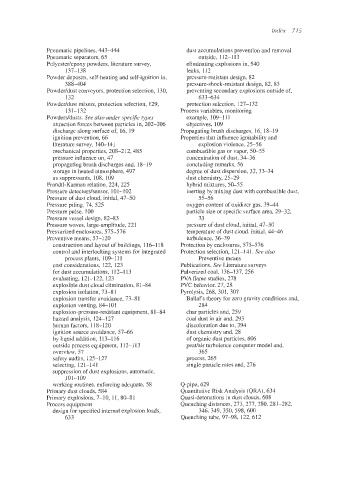Page 762 - Dust Explosions in the Process Industries
P. 762
Index 715
Pneumatic pipelines, 443-444 dust accumulationsprevention and removal
Pneumatic separators, 65 outside. 112-113
Polyester/epoxypowders, literature survey, eliminating explosions in, 540
137-138 leaks, 112
Powder deposits. self-heatingand self-ignitionin, pressure-resistantdesign, 82
388404 pressure-shock-resistantdesign, 82, 83
Powderldust conveyors,protection selection, 130, preventing secondary explosions outside of,
132 633-634
Powderldust mixers, protection selection, 129, protection selection, 127-132
131-132 Process variables, monitoring
Powdersldusts. See also under spec$c Qpes example, 109-1 11
attraction forces between particles in, 202-206 objectives, 109
discharge along surface of, 16, 19 Propagating brush discharges, 16, 18-19
ignition prevention, 66 Properties that influenceignitability and
literature survey, 140-141 explosion violence. 25-56
mechanical properties, 208-2 12,485 combustiblegas or vapor, 50-55
pressure influence on, 47 concentrationof dust, 34-36
propagating brush discharges and, 18-19 concludingremarks, 56
storage in heated atmosphere,497 degree of dust dispersion, 32, 33-34
as suppressants, 108, 109 dust chemistry, 25-29
Prandtl-Karmanrelation, 224,225 hybrid mixtures, 50-55
Pressure detectorslsensor,101-102 inerting by mixing dust with combustible dust,
Pressure of dust cloud, initial, 47-50 55-56
Pressure piling, 74, 52.5 oxygen content of oxidizer gas, 39-44
Pressure pulse, 100 particle size or specific surface area, 29-32,
Pressure vessel design, 82-83 33
Pressure waves, large-amplitude,221 pressure of dust cloud, initial, 47-50
Pressurized enclosures, 575-576 temperature of dust cloud, initial, 4446
Preventive means, 57-120 turbulence, 36-39
construction and layout of buildings, 116-118 Protection by enclosures, 575-576
control and interlocking systems for integrated Protection selection, 121-141. See also
process plants, 109-1 11 Preventivemeans
cost considerations, 122, 123 Publications.See Literature surveys
for dust accumulations, 112-1 13 Pulverized coal, 136-137,256
evaluating, 121-122, 123 PVA flame studies, 278
explosible dust cloud elimination, 81-84 PVC behavior, 27,28
explosion isolation, 73-8 1 Pyrolysis, 268, 301, 307
explosion transfer avoidance, 73-81 Ballal’s theory for zero gravity conditions and,
explosion venting, 64-101 284
explosion-pressure-resistantequipment, 81-84 char particles and, 259
hazard analysis. 124-127 coal dust in air and, 293
human factors, 118-120 discoloration due to, 394
ignition source avoidance, 57-66 dust chemistry and, 28
by liquid addition, 113-116 of organic dust particles, 606
outside process equipment, 112-113 peatfair turbulence computer model and,
overview, 57 365
safety audits, 125-127 process, 265
selecting, 121-14 1 single particle rates and, 276
suppression of dust explosions, automatic.
101-109
working routines, enforcing adequate, 58 Q-pipe, 629
Primary dust clouds, 584 QuantitativeRisk Analysis (QRA), 634
Primary explosions. 7-10, 11, 80-81 Quasi-detonationsin dust clouds, 608
Process equipment Quenching distances. 273, 277. 280. 28 1-282,
design for specified internal explosion loads, 346,349,350,598,600
633 Quenching tube, 97-98, 122,612

